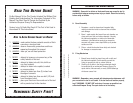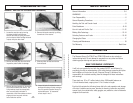
-5-
-14-
© Copyright 2004 SIMPSON STRONG-TIE COMPANY INC.
© Copyright 2004 SIMPSON STRONG-TIE COMPANY INC.
WARNING
STUDY AND UNDERSTAND THESE RULES BEFORE OPERATING THESE TOOLS.
Before Loading and Firing
1. Never operate the tool without checking to see if the barrel is free of
obstructions and that the tool is clean and in good working condition.
2. Never attempt to alter, modify or manufacture parts for use in your
Simpson Strong-Tie tool, this can cause malfunctions and result in unsafe
functioning of the tool. Use only genuine Simpson Strong-Tie parts,
fasteners and power loads at all times.
3. Operators and bystanders must wear eye; ear and head protection at all
times. Serious injury or death can occur if these safety items are not used.
4.
REMEMBER:
use common sense and good judgement. Use this tool for its
intended purpose only. Know the material you are fastening into making
certain it is compatible with the powder actuated tool.
Prepare for Loading
1.
ALWAYS
open the tool before handling it to be certain it is unloaded.
2.
ALWAYS
insert the fastener first. Make sure you never double load
the fasteners.
3.
NEVER
load or fire the tool in an explosive atmosphere or when
flammables are nearly.
4.
NEVER
allow bystanders to gather around you when using the tool.
5.
ALWAYS
check to be sure that the tool is clean. Excessive dirt or debris
can cause accidental firing or misfiring of the tool.
6.
NEVER
use improper power loads or fasteners in the tool, as the may
be unsafe or damage the tool.
7.
NEVER
guess - before fastening into any unknown base material,
particularly in walls, perform the center punch test described in this
manual.
8.
NEVER GUESS
- once you determine that the base material is suitable,
make a test fastening with a brown (P27SL2) strip load. If the brown
does not set the fastener try green (P27SL3), yellow (P27SL4), red
(P27SL5) until the proper power is determined.
MAKING SAFE FASTENINGS
3. Thickness of base material is perhaps the most important consideration
for good safe fastenings. In concrete the thickness must be 3 times the
shank penetration, in other words, for 1" of shank the concrete must be
at least 3" thick. In steel thickness must be equal to or greater than the
diameter of the shank.
D. DO NOT USE THESE TOOLS FOR FASTENING INTO:
1. Vertical mortar joints.
2. Bricks
3. Hollow block or tile
4. Glazed tile
5. Glass
6. Hardened or tool grade steel
7. Cast iron
8. Welded areas or torch cuts
9. Spring Steel
10. Natural rock
E.
REMEMBER:
If you are unsure of the base material being suitable, perform
the center punch test described on page 13; failure to do so may cause
serious injury or death.












